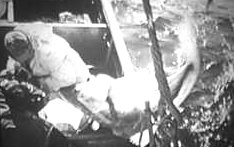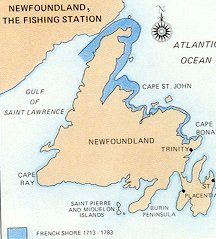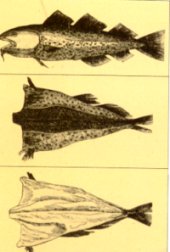
The Waters of Newfoundland at one time produced enough fish to feed most of western Europe. But the emergence of a stable on the island was slow, resisted all the way by fishermen who preferred to rule like petty dictators.
In 1497 John Cabot, sailing from Bristol under the English flag, discovered the island of Newfoundland. The island itself did not appear to boast much wealth, but Cabot was astounded by the vast quantity of cod fish to be found in the coastal waters and offshore banks. News that there were plenty of cod to be exploited in the waters of the New-found-land spread rapidly through the seaports of Western Europe.
Fishermen from England, France, Portugal and Spain soon began crossing the North Atlantic annually to engage in the summer fishery, and by the 1580's St. John's became the principal port of call for these fleets. At first the Portuguese, French and Spanish led the way and the English fleet was quite small, but eventually, it was the English fleet that came to dominate the coastal waters of the island.
Inshore and On the Banks
By the end of the fifteenth century, Europeans were consuming cod and herring in great quanity, especially during the winter months, Lent and on days designated for fast and abstinence by the Roman Catholic church. Thus, when John Cabot discovered that enormous quantities of cod fish were available at Newfoundland, European fishermen and investors pounced on this new resource.
They soon realized that two kinds of cod fishing could be prosecuted in this region. In the shallow waters of the large banks off the coast, fishermen could fish for weeks and months among the rich cod stocks, salting their fish in the holds of their ships. These ships came ashore periodically to obtain bait, fresh water, firewood, and also to find refuge in bad weather.
As well as this "bank" fishery, another fishery started at the same time in the coastal waters off the island where a "shore" fishery was dependent on the cod which migrated into the coastal waters every summer in search of food, especially caplin and squid. Fishermen engaged in the shore fishery could live ashore, where they were more comfortable, and where they could dry their salted cod before bringing it home to Europe.
Fishermen with plenty of salt at their disposal were inclined to spend time catching and salting, whereas those salt supplies were scarce were encouraged to salt lightly, and dry the fish on the coast of Newfoundland. Not having the supplies of salt which were available to the Spaniards, Portuguese, and French, English fishermen concentrated on the shore fishery and produced a light-salted, well-dried product. It was this total commitment to the shore fishery that distinguished the English during the sixteenth century.
During the late sixteenth century the English fishery benefitted from two developments. First of all, France became an importer of England's Newfoundland fish, providing that industry with its first major foreign market. Then, in 1585, the English government sent out a small naval force under Bernard Drake with secret instructions to attack the Spanish (and Portuguese) fishing fleets. The Spanish government began to organize for the invasion of England, and in 1588 a naval invasion force, the famous Armada, was defeated. Although a few Spanish ships continued to visit Newfoundland, the major Spanish-Newfoundland fishery came to an end in the 1580s. Meanwhile, the Spanish needed Newfoundland saltfish, and when they were no longer able to produce it, they began to import it. This new demand from France, Spain and Portugal led to a rapid growth of the English cod fishery during the final years of the century.

Meanwhile, the English-Newfoundland cod fishery was confined to fishermen from a specific part of England - the West Country. The West Country, the West of England, or the Western Counties, were the names given to those counties that comprise the southwest of England - Cornwall, Devon, Dorset, Somerset, and Hampshire. It was from this area that fishermen had gone overseas to Iceland in search of cod, and it was from Bristol in Somerset that John Cabot had set out on his voyage to the new world in 1497.
During the early years of the Newfoundland fishery the West Country ports had very little competition, but this changed when it became clear that the fishery was a very lucrative industry. Consequently, by the early 1600s, other ports in England, Wales and even Ireland, began to show an interest in the new enterprise. In 1610 a group of merchants from London and Bristol formed the London Bristol company and received a charter to establish a colony in Newfoundland. They sent out colonists under a governor, John Guy, and settled the first colony at Cupids in Conception Bay.
During the next several decades others followed the example of the London Bristol Company, but these colonies were not financially successful and investors all gave up after a few years. After 1660 the English government discouraged settlement, concluding that Newfoundland should remain exclusively a fishing station.
Bye Boats
By the 1620's the English migratory fishery was beginning to experience problems. Most troublesome were the many wars which plagued the fishery, beginning in the 1620s with wars between England and Spain and France, but continuing for much of the century. Wars created many problems for the fisheries, the major one being the increased danger of sailing back and forth across the Atlantic. In addition, wherever there was war with Spain a lucrative market was closed to Newfoundland fish. War also brought manpower problems: The English navy depended on migratory fishermen to man its ships in wartime. Crews were recruited by force, and trained fishermen-sailors were always preferred. Also, during 1620-1640 English waters were plagued by "Sallee Rovers" who captured many fishing ships, usually killing or enslaving captives who would not join them.
Problems in the cod fishery encouraged the development of a new branch of the migratory fishery - the bye boat fishery. The old fishing ship fishery was costly. The fishing ship had to operate at full capacity; insurance was expensive; and the cost of having the ship tied up in Newfoundland during the summer was high. During the 1640s some men began the practice of hiring small crews and finding passage to Newfoundland for themselves, their crews, a fishing boat or two, and supplies and equipment. Once in Newfoundland they followed the usual practice, building a fishing "room" and fishing during the season. In the fall they sold their catch to a visiting sack ship and, again, found transportation back to England.
Therefore, by the mid-1660s The English-Newfoundland fishery included the old fishing ship fishery, the bye boat fishery, and a small inhabitant fishery carried on by about 1,500 men, women and children.
During the period 1660-1690 the English government wrestled with the ideal of permanent colonization on Newfoundland. But the West Country ports advocated that prohibition of the bye boat fishery and the removal of inhabitants as a solution to the problems facing the fishery. The government was swayed and for a brief period in the 1670s actually attempted to remove the inhabitants from the island. It soon became obvious, however, that this would not solve the problems of the fishery; so inhabitants were allowed to stay, though they were not given any encouragement of assistance.
The Growth of Permanent Settlement
An Act passed in 1699 formally recognized the presence of inhabitants, but they were forbidden to encroach on fishing rooms used by the migratory fishing ships. By this time, however, the employment of caretakers by the fishing ships encouraged more settlement. This development, in turn, led to demands for law during the winter months because, without it, all property was vulnerable to thieves and vandals.
 The constant appeal for some law and order to help in the protection of property during the off-
season finally prompted the British Government to appoint a governor for the island with
instructions to designate constables and magistrates. Therefore, in 1729 the commander of the
naval force was given the duties of Governor of Newfoundland. The governor was required to
stay in Newfoundland during the winter, but he and the magistrates and constables brought an
element of security to the island and its inhabitants. The problem, however, was complicated by
the fact that the fishing admirals (the first captain to reach each harbour in the spring) had a
customary right to maintain law and order in each harbour. The fishing admirals resented having
to share their legal powers with magistrates. Nevertheless, within a few years both groups were co-
operating with each order since the only men in Newfoundland qualified to act as magistrates
were the agents of the West Country merchants who also employed and suppled the fishing
admirals.
The constant appeal for some law and order to help in the protection of property during the off-
season finally prompted the British Government to appoint a governor for the island with
instructions to designate constables and magistrates. Therefore, in 1729 the commander of the
naval force was given the duties of Governor of Newfoundland. The governor was required to
stay in Newfoundland during the winter, but he and the magistrates and constables brought an
element of security to the island and its inhabitants. The problem, however, was complicated by
the fact that the fishing admirals (the first captain to reach each harbour in the spring) had a
customary right to maintain law and order in each harbour. The fishing admirals resented having
to share their legal powers with magistrates. Nevertheless, within a few years both groups were co-
operating with each order since the only men in Newfoundland qualified to act as magistrates
were the agents of the West Country merchants who also employed and suppled the fishing
admirals.
Furthermore, the Church of England began to send out missionaries to care for the inhabitants, (although Roman Catholics were still denied any chance to practice their religion in public). Finally, the introduction of the potato in 1750 meant that inhabitants now enjoyed a reliable vegetable with a high vitamin C content. Soon every permanent home had a potato garden. The end result of all these changes was that the migratory fishery was gradually giving way to the inhabitant fishery.
The final half of the eighteenth century was almost entirely devoted to war and as always, whenever France and England fought Newfoundland was involved. The Seven Years War (1756-1763) resulted in France losing all its North American possessions, with the exception of the "French Shore" in Newfoundland, which was only useful for the fishing fleet during the summer. As a permanent base, France received the island of St. Pierre and Miquelon on the south coast.
In 1775 England's American colonies cut off all supplies to the Newfoundland fishery before going to war with the mother country, Newfoundland and the coast of Labrador (which had been placed under the Newfoundland Governor in 1763) were raided and bank ships were captured. Peace was restored in 1783, but 10 years later France and England were at war again, and, with the exception of a brief respite, this war continued until 1815.
The Emergence of a Colony
 During the final years of the eighteenth century, Newfoundland continued to change. The old
fishing ship fishery finally collapsed during the Seven Years War as its men were all pressed into
the Royal Navy. The bye boat fishery, as a West Country industry, could not survive as more and
more men settled on their property to become permanent inhabitants, rather than risk losing their
property to others.
During the final years of the eighteenth century, Newfoundland continued to change. The old
fishing ship fishery finally collapsed during the Seven Years War as its men were all pressed into
the Royal Navy. The bye boat fishery, as a West Country industry, could not survive as more and
more men settled on their property to become permanent inhabitants, rather than risk losing their
property to others.
The sack ship fishery continued, but the most important component of the migratory fishery during these late years was the bank fishery.
At the same time, the inhabitant fishery gradually, became stronger. In 1788 this branch of the industry produced over 23,000,000 kilograms of salt fish which was more than the entire industry had produced prior to 1750. The same year "British fishing ships", produced 20,000,000 kilograms. Combined with the smaller amount produced by the bye boat fishery, the total catch in 1788 was a record 48,000,000 kilograms. This huge quantity caused gluts in the market, a drop in price, and bankruptcies, and the British government was forced to pass a new Act giving Newfoundland a modern judiciary, in 1792.
The war which began in February 1793, between Britain and France changed forever the course
of Britain's migratory fishery to Newfoundland. The bank fishery was vulnerable to French
attacks; so it disappeared from the scene. When the war ended it was apparent that Newfoundland
had a sufficiently large inhabitant population to supply the markets with saltfish. Instead of a
fishing station, Newfoundland had finally became a colony like the others, with its own
government, judicial system and permanent population.